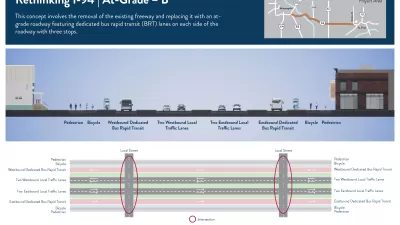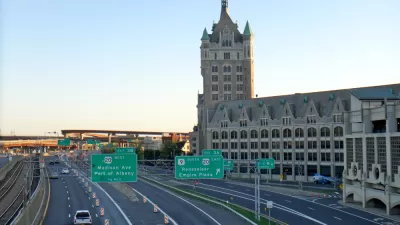The program, aimed at supporting highway removals and other projects that work to reverse the impacts of freeway construction, is light on accountability and performance measures, according to a new report.

A report from the U.S. Government Accountability Office found that the Department of Transportation’s Reconnecting Communities Pilot Program does not have clear, measurable objectives or performance benchmarks, writes Dan Zukowski in Smart Cities Dive.
Reconnecting Communities targets projects that mitigate the damage of freeways by removing them, building accommodations for pedestrians and cyclists, or otherwise improve walkability and connectivity in the areas surrounding them. But without clear goals and measures, it could end up contributing to road expansion projects and band-aid solutions that only superficially improve neighborhood connectivity.
The report recommended that the Department of Transportation take three key steps to improve the program:
-
Establish performance measures in line with the program’s objectives.
-
Develop a plan to collect and analyze data from the program aimed at evaluating results.
-
Find a way to share learnings from the program, such as whether the DOT is attracting enough high-quality projects and whether they can be completed in a reasonable timeframe.
FULL STORY: DOT’s Reconnecting Communities highway removal program lacks performance measures: GAO report

Alabama: Trump Terminates Settlements for Black Communities Harmed By Raw Sewage
Trump deemed the landmark civil rights agreement “illegal DEI and environmental justice policy.”

Study: Maui’s Plan to Convert Vacation Rentals to Long-Term Housing Could Cause Nearly $1 Billion Economic Loss
The plan would reduce visitor accommodation by 25% resulting in 1,900 jobs lost.

Planetizen Federal Action Tracker
A weekly monitor of how Trump’s orders and actions are impacting planners and planning in America.

Wind Energy on the Rise Despite Federal Policy Reversal
The Trump administration is revoking federal support for renewable energy, but demand for new projects continues unabated.

Passengers Flock to Caltrain After Electrification
The new electric trains are running faster and more reliably, leading to strong ridership growth on the Bay Area rail system.

Texas Churches Rally Behind ‘Yes in God’s Back Yard’ Legislation
Religious leaders want the state to reduce zoning regulations to streamline leasing church-owned land to housing developers.
Urban Design for Planners 1: Software Tools
This six-course series explores essential urban design concepts using open source software and equips planners with the tools they need to participate fully in the urban design process.
Planning for Universal Design
Learn the tools for implementing Universal Design in planning regulations.
Caltrans
Smith Gee Studio
Institute for Housing and Urban Development Studies (IHS)
City of Grandview
Harvard GSD Executive Education
Toledo-Lucas County Plan Commissions
Salt Lake City
NYU Wagner Graduate School of Public Service





























